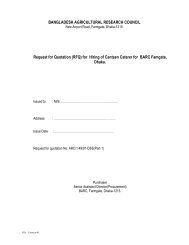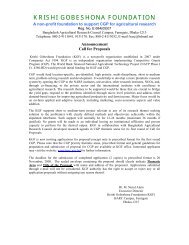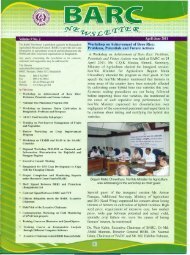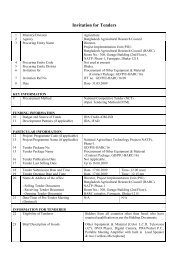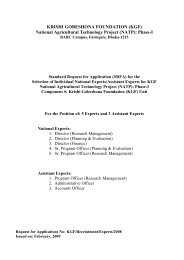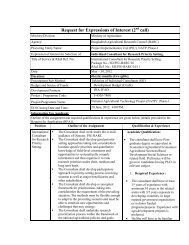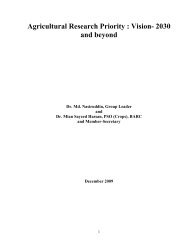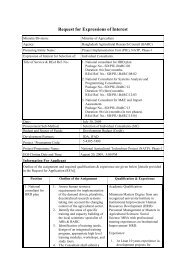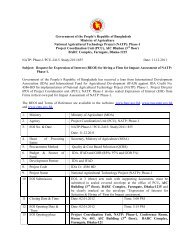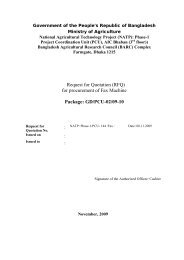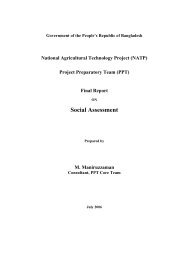ICT in Agriculture and Disaster Management - Bangladesh ...
ICT in Agriculture and Disaster Management - Bangladesh ...
ICT in Agriculture and Disaster Management - Bangladesh ...
Create successful ePaper yourself
Turn your PDF publications into a flip-book with our unique Google optimized e-Paper software.
1. Introduction<br />
<strong>Bangladesh</strong> is one the most densely populated countries of the world. The country has<br />
a l<strong>and</strong> area of 14.83 million hectares (Mha), population of over 149 million with a<br />
density of more than 1000 persons per km2, which is one of the highest <strong>in</strong> the world.<br />
The effective l<strong>and</strong> area of the country is roughly 12.31 Mha, about 0.98 Mha is<br />
occupied by rivers <strong>and</strong> 2.19 Mha are under forest cover (BBS, 2008). The country is<br />
predom<strong>in</strong>antly flat with almost 80% of the l<strong>and</strong> area occupied by floodpla<strong>in</strong>s <strong>and</strong><br />
piedmont pla<strong>in</strong>s, about 8% by slightly uplifted fault blocks (terrace) <strong>and</strong> about 12% by<br />
hills. Dur<strong>in</strong>g the last three of decades the population has grown rapidly, which has put<br />
<strong>in</strong>tense pressure on the scarce l<strong>and</strong> resource of the country. The l<strong>and</strong>-man ratio is<br />
decreas<strong>in</strong>g at an alarm<strong>in</strong>g rate; the current estimated per capita arable l<strong>and</strong> st<strong>and</strong>s at<br />
0.05 ha only.<br />
Livestock<br />
13%<br />
Forestry<br />
8%<br />
Crops<br />
57%<br />
Fisheries<br />
22%<br />
The economy of <strong>Bangladesh</strong> is based on<br />
agriculture, <strong>in</strong>dustry <strong>and</strong> services. The gross<br />
domestic product (GDP) expressed as<br />
purchase power parity is US$209.2 billion,<br />
which is equivalent to more than BDT 14600<br />
billion. The agriculture sector contributes a<br />
major share <strong>in</strong> the GDP, which is about 20.0%<br />
<strong>and</strong> employs about 48.07% of the work<strong>in</strong>g<br />
force. Services sector is also an important<br />
sector <strong>in</strong> the economy of the country about<br />
50% of the GDP is generated through this<br />
sector <strong>and</strong> engages 43.28% of the work force.<br />
Aga<strong>in</strong>, among the sub-sectoral contributions<br />
of agriculture sector is dom<strong>in</strong>ated by crops<br />
(57 %), followed by fisheries (22%). Figure 1<br />
depicts the sub-sectoral contributions to<br />
agricultural GDP.<br />
Figure 1. Sub-sectoral Contributions to Agricultural GDP<br />
Accord<strong>in</strong>g to Intergovernmental Panel on Climate Change (IPCC), <strong>Bangladesh</strong> will be<br />
one of the worst victims of climate change. Sea level will be <strong>in</strong>creased due to rise <strong>in</strong><br />
temperature <strong>and</strong> the frequency of cyclone-storms will be <strong>in</strong>creased. As a result, food<br />
security will be <strong>in</strong> jeopardy <strong>and</strong> different types of natural calamities will put lives at<br />
risk. On top of these, high population density will make the problem more serious.<br />
Globally, the impact of climate change on agriculture has been studied extensively for<br />
various crops at many different scales. Available <strong>in</strong>formation shows that the tropical<br />
<strong>and</strong> subtropical countries would be more vulnerable to the potential impacts of global<br />
warm<strong>in</strong>g. <strong>Bangladesh</strong> is likely to be one of the worst hit countries of the globe, be<strong>in</strong>g a<br />
humid-tropical country.<br />
The people of <strong>Bangladesh</strong> have been adapt<strong>in</strong>g to the risks of floods, droughts <strong>and</strong><br />
cyclones for centuries. High population density, very frequent occurrence of natural<br />
disasters, poor <strong>in</strong>frastructure <strong>and</strong> fragile economic resilience to shocks, makes the<br />
country especially vulnerable to climatic risks. Heavy reliance of rural people on<br />
agriculture <strong>and</strong> natural resources <strong>in</strong>creases their vulnerability to climate change.





